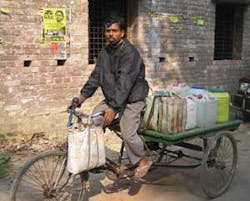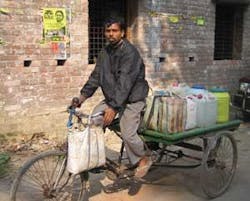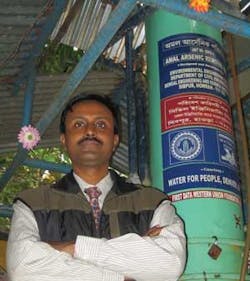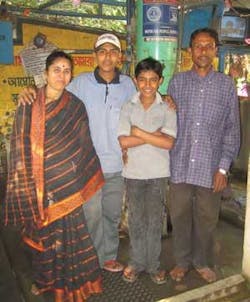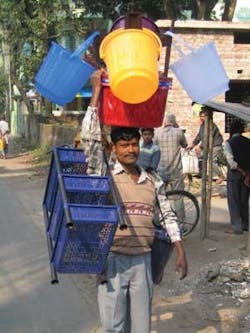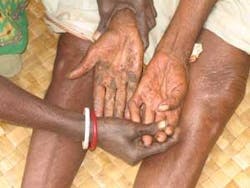By David Stevenson
Water For People’s work to improve water supplies in West Bengal, India, also touches on the added economic benefits to communities where arsenic removal filters have been installed.
In rural West Bengal, India, life is tenuous for millions of people. Desperate poverty, hunger, and disease are a daily reality. To make matters worse, their water is killing them. With every drink and every meal, hundreds of thousands of people are slowly poisoned by the very water they need to survive.
Residents in eight of this region’s 19 districts are drinking and cooking with groundwater contaminated with naturally occurring, highly toxic arsenic. Tasteless and colorless, the arsenic has slowly seeped into their water sources and then into their bodies.
Thankfully, village-by-village, simple, locally developed solutions are making a change for the better. These solutions provide much more than safe water. They’re empowering communities and contributing to local economies by creating new business and job opportunities.
Source of the Problem
Arsenic is a naturally occurring semi-metallic compound found in groundwater around the world — including in Bangladesh, Taiwan, Japan, Mexico, parts of the United States and India. Some argue the increasing occurrence of arsenic in groundwater might be the result of a rapid and significant drawdown of aquifers as we struggle to meet water demands.
While arsenic may be tasteless and odorless, the human impact is deadly evident. Early indications appear in the form of dark spots on the chest, back, limbs and gums; then in the more advanced stages, wart-like skin eruptions on the hands, feet, and torso. Continuing exposure can result in enlargement of the liver, kidneys and spleen, developing into malignant tumors and even disorders of the gastrointestinal, circulatory and nervous systems.
The arsenic problem hasn’t always been present in West Bengal. It’s actually a result of efforts to solve microbiological contamination of surface water during the 1970s and 1980s when tube wells were installed throughout the region. The switch to groundwater came with a deadly price and awareness of the issue was slow to come. Due to extreme poverty of the region, affected people often hesitated to seek medical care. By then, the damage was done. It was in the late 1980s that scientists began to find evidence of arsenic contamination in the groundwater. And, by the 1990s, the extent of the health impact became widely known.
Sustainable Solution Partners
Water For People began working in India in 1996. Its initial effort was a small pilot program designed to help eliminate the health threats of arsenic in rural village water supplies. Soon the NGO partnered with Bengal Engineering & Science University to develop a local, sustainable solution.
After pursuing a number of options, the university developed a simple arsenic-removal filter incorporating activated alumina for use at community wellheads. The wellhead unit consists of a 12-inch diameter, 7-foot, 2-inch-tall stainless steel column. Water flows through a 51-inch layer of activated alumina and then through an 8-inch layer of gravel. Every eight to 12 months the filter media is regenerated and the waste safely contained. One wellhead unit can serve up to 300 families and is expected to last for 10 to 15 years, with little maintenance required.
The filter incorporates a simple, highly effective technology, is locally manufactured, easy to operate (no electricity required), easy to maintain, and relatively inexpensive — about $2,000 for each wellhead unit. Most important, the technology is sustainable, offering effective protection for years to come.
Healthy Results
Working with the local villages, water committees were formed to help implement installations and encourage ongoing local input and control. To date, Water For People has helped finance the installation of 110 of these units providing safe, arsenic-free water for more than 33,000 people in multiple villages across West Bengal. In villages where wellhead units have been installed, the incidence of arsenic poisoning has dropped dramatically. People are reporting living healthier and more productive lives.
The difference according to one woman indicates a variety of positive changes. “I used to have indigestion and chronic dysentery. Now, all these problems are gone, and I have an appetite. I used to spend 150 rupees (US$3.43) each month on medicine, and now I save this money.”
Economic Opportunity, Too
Dipak Das churns the pedals of his three-wheeled bike earnestly, eyes straight ahead. He’s focused on safely navigating the endless maze of bumps, holes, oncoming traffic, pedestrians, and blowing dust. Immediately behind him packed tightly on the flat platform that’s wedged between the two rear wheels rest 20-or-so jiggling jugs of his most precious cargo — safe, filtered arsenic-free drinking water from the wellhead.
Forty-five families depend on the arsenic-free filtered water he delivers. The 2,800 rupees (US$70) he earns each month is a good living by Indian standards. Before, he ran a roadside tea shop, worked longer hours and made less money. Now, his deliveries require only four hours a day, giving him time to pursue other business opportunities. For Nirmal De and his family, their sole source of income is work related to the arsenic filter in Daharthuba Village where they live. He used to work in a plastic toy factory that has since closed. He started out by delivering water to three families. Now, he’s up to 50. On every delivery, he attempts to sell the service to other families along his route.
Sumitra, his wife, is the paid caretaker for the filter. She spends four hours every morning and three hours every evening operating the pump. She must periodically backwash the filter to ensure its effectiveness. She also keeps the platform clean throughout the day. The pump station has become the center of the community and even has a television to entertain women as they wait. Sumitra tries to make sure women don’t get too absorbed in their TV viewing and lose their place in line. An older son, Sudip also helps out at the filtration station and with deliveries.
Besides the water delivery, a variety of other business enterprises often emerge around the arsenic filters. There are vendors who sell jerry cans for carrying the water. Others sell food and snacks at the wellhead. And at every station, an individual — like Sumitra — earns a salary to collect and record water payments from villagers.
Conclusion
Water For People makes it a point to support our partners in West Bengal, who in turn work closely with communities. The goal is to obtain commitment to each project from community members, enabling them to take ownership of its long-term operation. In 2006, Water for People opened an office in Kolkata with a full-time country coordinator, Rajashi Mukherjee, to facilitate the work in the region.
In the second most populous country in the world, Water For People is committed to help meet the most basic water and sanitation needs of thousands of India’s poorest. By partnering with local government entities, nongovernmental organizations, the local private sector and others, success will come — day-by-day, village-by-village.
Acknowledgment:
The author would like to thank Water For People marketing communications director John Kayser, whose photos illustrate this article. Founded in 1991, the Denver-based private, nonprofit international development organization supports safe drinking water and sanitation projects in developing countries. Contact: +1-303-734-3476, [email protected] or www.waterforpeople.org
Author’s Note:
David Stevenson is a freelance writer who lives in Denver, Colorado. He has participated in numerous community work projects with the people of the Dominican Republic, Venezuela, and the San Luis Valley in southern Colorado.
